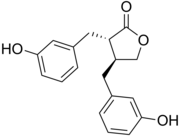
| |
| Names | |
|---|---|
| Preferred IUPAC name
(3R,4R)-3,4-Bis[(4-hydroxyphenyl)methyl]oxolan-2-one | |
| Other names
(−)-Enterolactone
| |
| Identifiers | |
3D model (JSmol)
|
|
| Abbreviations | ENL |
| ECHA InfoCard | 100.162.708 |
| KEGG | |
PubChem CID
|
|
| UNII | |
CompTox Dashboard (EPA)
|
|
| |
| Properties | |
| C18H18O4 | |
| Molar mass | 298.338 g·mol−1 |
Except where otherwise noted, data are given for materials in their standard state (at 25 °C [77 °F], 100 kPa).
| |
Enterolactone is a organic compound classified as an enterolignan. It is formed by the action of intestinal bacteria on plant lignan precursors present in the diet.
Sources[edit]
Many dietary plant lignan precursors, such as secoisolariciresinol, matairesinol, lariciresinol, pinoresinol, and sesamin, can be metabolized by gut microbes to enterolactone.[1][2][3] In edible plants lignans are bound to the fiber fraction and therefore fiber-rich food products, such as cereals, vegetables, fruits and berries, are generally good sources of lignans and enterolactone. The richest known dietary sources of enterolactone precursors are flaxseed and sesame seed.[4][5][6] Since enterolactone is produced by specific species of gut microbiota, the capacity to produce it varies between people.[7] Antibiotic treatments can abolish the capacity to produce enterolactone. It may take up to a year before enterolactone production is restored.[8][9]
Health effects[edit]
Enterolactone is suggested to possess beneficial health effects in humans. In epidemiological studies lower concentrations of enterolactone have been observed in breast cancer patients compared to healthy controls, which may suggest that enterolactone is anti-carcinogenic. Enterolactone and lignans may also be protective against cardiovascular disease.[10][11]
References[edit]
- ^ Lampe JW (2003). "Isoflavonoid and lignan phytoestrogens as dietary biomarkers". J Nutr. 133 (Suppl 3): 956S–964S. doi:10.1093/jn/133.3.956S. PMID 12612182.
- ^ Peñalvo JL, Heinonen SM, Aura AM, Adlercreutz H (May 2005). "Dietary sesamin is converted to enterolactone in humans". J. Nutr. 135 (5): 1056–1062. doi:10.1093/jn/135.5.1056. PMID 15867281.
- ^ Heinonen, S; Nurmi, T; Liukkonen, K; Poutanen, K; Wähälä, K; Deyama, T; Nishibe, S; Adlercreutz, H (2001). "In vitro metabolism of plant lignans: New precursors of mammalian lignans enterolactone and enterodiol". Journal of Agricultural and Food Chemistry. 49 (7): 3178–86. doi:10.1021/jf010038a. PMID 11453749.
- ^ Milder, I. E.; Arts, I. C.; Van De Putte, B; Venema, D. P.; Hollman, P. C. (2005). "Lignan contents of Dutch plant foods: A database including lariciresinol, pinoresinol, secoisolariciresinol and matairesinol". The British Journal of Nutrition. 93 (3): 393–402. doi:10.1079/bjn20051371. PMID 15877880.
- ^ Thompson, L. U.; Boucher, B. A.; Liu, Z; Cotterchio, M; Kreiger, N (2006). "Phytoestrogen content of foods consumed in Canada, including isoflavones, lignans, and coumestan". Nutrition and Cancer. 54 (2): 184–201. doi:10.1207/s15327914nc5402_5. PMID 16898863. S2CID 60328.
- ^ Smeds, A. I.; Eklund, P. C.; Sjöholm, R. E.; Willför, S. M.; Nishibe, S; Deyama, T; Holmbom, B. R. (2007). "Quantification of a broad spectrum of lignans in cereals, oilseeds, and nuts". Journal of Agricultural and Food Chemistry. 55 (4): 1337–46. doi:10.1021/jf0629134. PMID 17261017.
- ^ Clavel, T; Doré, J; Blaut, M (2006). "Bioavailability of lignans in human subjects". Nutrition Research Reviews. 19 (2): 187–96. doi:10.1017/S0954422407249704. PMID 19079885.
- ^ Setchell, K. D.; Lawson, A. M.; Borriello, S. P.; Harkness, R; Gordon, H; Morgan, D. M.; Kirk, D. N.; Adlercreatz, H; Anderson, L. C.; Axelson, M (1981). "Lignan formation in man--microbial involvement and possible roles in relation to cancer". Lancet. 2 (8236): 4–7. doi:10.1016/s0140-6736(81)90250-6. PMID 6113409. S2CID 39049097.
- ^ Kilkkinen, A; Pietinen, P; Klaukka, T; Virtamo, J; Korhonen, P; Adlercreutz, H (2002). "Use of oral antimicrobials decreases serum enterolactone concentration". American Journal of Epidemiology. 155 (5): 472–7. doi:10.1093/aje/155.5.472. PMID 11867359.
- ^ Adlercreutz, H (2007). "Lignans and human health". Critical Reviews in Clinical Laboratory Sciences. 44 (5–6): 483–525. doi:10.1080/10408360701612942. PMID 17943494. S2CID 31753060.
- ^ Peterson, J; Dwyer, J; Adlercreutz, H; Scalbert, A; Jacques, P; McCullough, M. L. (2010). "Dietary lignans: Physiology and potential for cardiovascular disease risk reduction". Nutrition Reviews. 68 (10): 571–603. doi:10.1111/j.1753-4887.2010.00319.x. PMC 2951311. PMID 20883417.